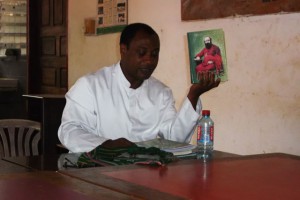We held our meeting this 14th Feb. We first have a talk on Comboni Spirituality which was presented by our Spiritual Director Fr Godwin Kornu. First of all, he showed us the books that can help us in our journey: The Writings of Comboni, The passion of a life of Don Lozano, We the Heirs of Francesco Pierli. He then explained the word Spirituality by the way a person experiences God, him or herself and the world he/she is part of. The spirituality must be shaped by Christ but it is influenced by the time and our environment. And talking about the spirituality of a person demands to pass through the life, the history of the person, the way he experiences God. And this experience of an individual is unique. Father led us to discover that the “loving heart is a suffering heart” and “what is good is not relative” which means what is good cannot be determined by a tradition or a culture. What is good is good by itself. The relativism is one of the points that the Pope Emeritus Benedict condemned lots. (The theme is very broad so for now it is just an introduction).
 After the presentation, we moved on for some discussions. The minutes of the last meeting was read and few corrections made. From the matters arisen, we agreed to levy ourselves with an amount which can be paid from now up to the next second meeting. At last, we decided to have a recollection on the 14th March to redo ourselves in the Lenten Season. The meeting was then moved to closure with prayer and benediction. After this, we had an agape.
After the presentation, we moved on for some discussions. The minutes of the last meeting was read and few corrections made. From the matters arisen, we agreed to levy ourselves with an amount which can be paid from now up to the next second meeting. At last, we decided to have a recollection on the 14th March to redo ourselves in the Lenten Season. The meeting was then moved to closure with prayer and benediction. After this, we had an agape.
Justin Nougnui, coordinator.












